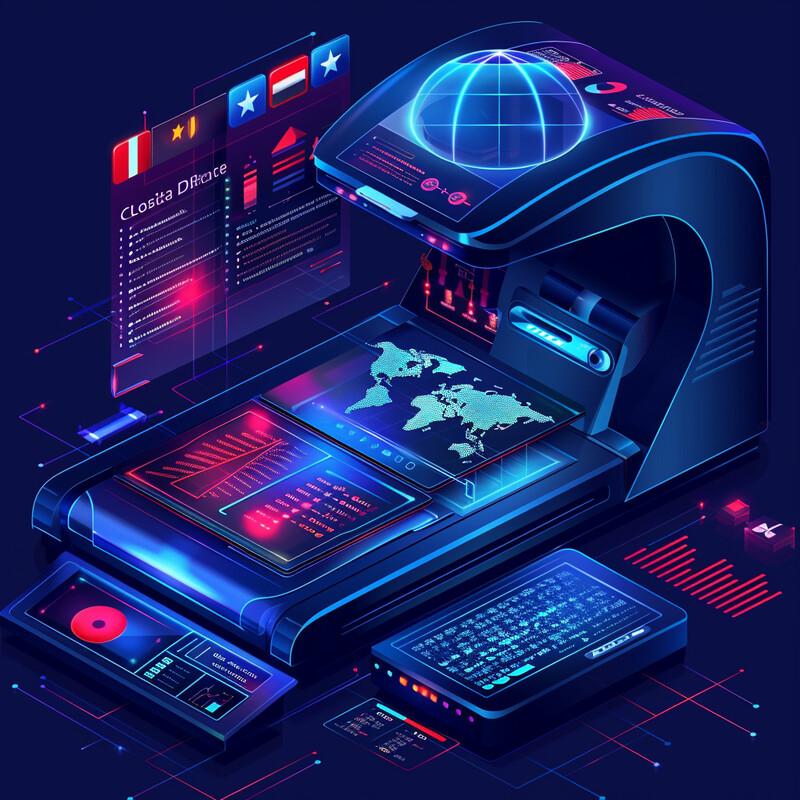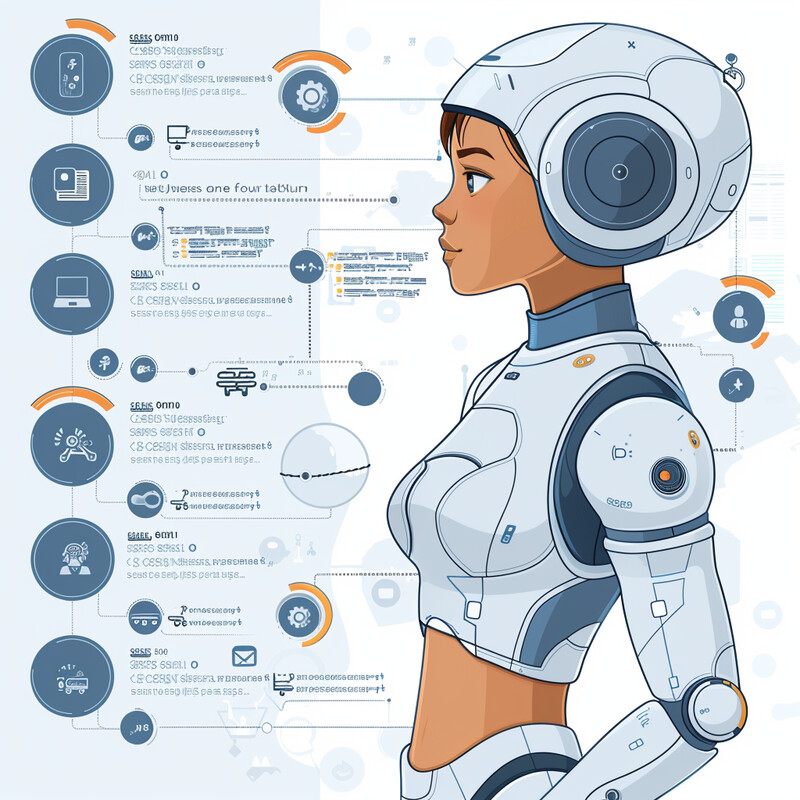1. Optical Character Recognition (OCR)
AI-driven OCR has dramatically improved the accuracy and versatility of text recognition. Modern OCR systems leverage deep learning models to handle diverse fonts, layouts, and even challenging inputs like low-quality scans or cursive writing. This results in far more precise conversion of images (printed or handwritten text) into machine-readable text than earlier rule-based methods. AI-powered OCR not only reads clean, typed documents with near-flawless precision, but it also tolerates noisy backgrounds and complex formatting that would baffle traditional OCR. The outcome is faster, more reliable text digitization that approaches human-level reading accuracy in ideal conditions.
-1.jpg)
Current AI OCR engines can exceed 95%–99% character-level accuracy on clear printed text, a level once unattainable with older techniques. However, no OCR system reaches a perfect 100%—for absolute accuracy, human review remains necessary for the occasional character errors. In practice, this means AI-based OCR drastically reduces the manual correction workload: for high-quality prints, only a tiny fraction of characters (often well below 5%) need human double-checking. The integration of machine learning has thus made OCR a largely “solved” problem for printed text, enabling automation in data entry and records digitization at scale.
2. Layout Analysis
AI techniques excel at analyzing a document’s layout, identifying structural elements (paragraphs, headings, images, tables, etc.) with a fidelity far beyond manual templating. Machine learning models—especially vision-based neural networks—are trained on countless page examples to distinguish content regions on a page. This means a scanned report or form can be parsed into its components automatically: text blocks versus figures, headers versus body text, and so on. By preserving the original layout hierarchy, AI ensures the digitized version isn’t just raw text, but a structured document that retains formatting and context. This is crucial for usability, as the end user can navigate the digital document much like the original, and downstream processes (like data extraction) know exactly where to look for specific information.

State-of-the-art AI models have achieved extremely high precision in document layout recognition. For example, a deep learning model trained on a large public dataset of documents (PubLayNet) attained an average precision of 97.3% in correctly identifying layout elements on scientific articles. On certain benchmarks, specific content types are recognized almost perfectly – one system reported 98.6% precision on detecting tables in documents. These numbers reflect near-human performance in segmenting page content. By contrast, older rule-based or template-based layout analysis would break down with even slight format changes. AI’s ability to generalize means it can maintain high accuracy across diverse document formats (business memos, research papers, invoices, etc.), ensuring that the structure of each digitized document is faithfully captured.
3. Language Detection
AI enables automatic language detection in digitized documents, a critical feature for global and multilingual contexts. Machine learning classifiers can identify the language of a document’s text by recognizing patterns in characters and words – often before full OCR is even performed. This ensures that the proper language-specific OCR model or processing pipeline is applied (for instance, using a Japanese OCR engine if the text is detected as Japanese). Beyond just flagging the language, advanced AI systems can handle multilingual documents, pinpointing where one language ends and another begins. The benefit is a seamless digitization workflow: a mixed stack of English, Spanish, and French documents can be processed without manual sorting, as the AI will route each to the appropriate recognition and translation models. Overall, language detection by AI adds intelligence to document digitization by making it adaptable to content in any tongue.

Modern AI language identification systems are remarkably comprehensive. Research has shown models that can distinguish over 1,300 languages with better than 90% accuracy (F1-score) on average. This encompasses not only major languages like English or Mandarin, but hundreds of less common languages – a scale unimaginable a decade ago. Such models, often based on neural networks and trained on enormous multilingual text corpora, approach what was once “solved” status for language ID in controlled settings. In real-world web data, challenges remain (especially for short or noisy texts), but these AI classifiers still provide a strong starting point. The U.S. tech industry has integrated similar language detection in many services (e.g. automatically detecting document language in cloud OCR APIs), typically supporting dozens to hundreds of languages with high accuracy. This broad capability ensures U.S. businesses and government agencies can automatically handle documents in Spanish, French, Chinese, Arabic, and more, without separate workflows for each language.
4. Handwriting Recognition
AI has greatly advanced handwriting recognition, a task traditionally fraught with difficulty due to varied writing styles and shapes. Deep learning models (such as convolutional neural networks combined with recurrent networks) now routinely decipher cursive and print handwriting that earlier systems would misread. This enables digitization of handwritten notes, letters, historical archives, and forms that were previously left to manual data entry. AI models learn from vast datasets of handwriting samples, capturing the common patterns in how humans draw characters. They’re also adept at context – for example, a language model can guess an unclear word by its context in a sentence, much like a person would. The result is that everything from old census forms to doctors’ prescriptions can be automatically transcribed into text. This capability opens up troves of analog information for search and analysis, bringing handwritten content into the digital fold with a level of accuracy and speed that keeps improving each year.

Cutting-edge handwriting recognition models are approaching print-level accuracy on standard tests. A 2024 study introduced a hybrid CNN–LSTM approach that achieved 98.5%+ accuracy on benchmark handwriting datasets (IAM and RIMES) – a remarkable performance historically. This means the AI correctly interpreted nearly all characters in those test sets, despite the inherent messiness of handwriting. In real-world terms, AI is already in use by postal services and banks: the U.S. Postal Service, for instance, now automatically reads about 99% of hand-addressed mail addresses, even those in sloppy cursive, with only the most challenging cases routed to human clerks. Similarly, banks deploy AI to read checks, and insurance companies scan claim forms, drastically reducing manual processing. These statistics underscore that what used to be an error-prone process – reading handwriting – has been transformed by AI into a fast, reliable step in document digitization.
5. Data Extraction and Classification
AI enables intelligent data extraction from digitized documents, automatically pulling out key information and organizing it. Instead of just creating a digital image or text, AI systems identify specific data points – for example, finding the invoice number, date, and total amount on a scanned invoice and exporting those into a database. This is often coupled with classification, where the AI assigns labels or categories to the document or its parts (e.g. recognizing a document as an invoice vs. a contract, then extracting fields accordingly). Under the hood, techniques like natural language processing and computer vision work together: the AI “reads” the content and understands context (names of parties, dollar amounts, dates, line-items, etc.). For businesses, this means replacing tedious manual data entry with automated pipelines. An accounts payable process, for instance, can ingest thousands of vendor invoices, and AI will output a structured ledger of all vendors, invoice numbers, due dates, and amounts without human effort. Overall, AI-driven data extraction turns unstructured documents into structured, actionable data instantly.

AI-based data extraction is delivering very high accuracy and efficiency gains in practice. In the insurance industry, for example, an AI system was reported to extract fields from policy documents with 99% accuracy, drastically reducing errors. The same solution cut operational costs by 60% and sped up document processing by about 50% after integration, compared to the previous manual workflow. Such statistics are echoed across industries adopting Intelligent Document Processing (IDP) platforms. Many organizations see returns on investment ranging from 30% up to 200% within the first year of deploying AI for data extraction, thanks to labor saved and faster throughput. As an example, a U.S. insurer implemented AI to parse claims forms and was able to reassign dozens of staff who formerly did manual data entry. These improvements illustrate why enterprises are rapidly embracing AI for document data extraction – the technology not only approaches human-level accuracy but also operates 24/7 at high speed, yielding substantial cost and time savings.
6. Document Categorization
AI automates the categorization of documents, sorting them into predefined classes or groups based on content. Using techniques from machine learning and NLP, an AI system can “read” a document and determine its type or topic—for example, distinguishing a legal contract from a medical record or routing an HR resume to a recruiting folder. This goes beyond simple keyword matching: modern models capture the semantics and context, so even if two documents don’t share exact words, the AI might recognize they both pertain to, say, financial statements. The result is a huge efficiency gain in document management. Rather than employees manually labeling or misfiling documents, the AI consistently applies the correct tags or categories. This supports fast retrieval (one can instantly pull up all tax forms or all customer feedback letters) and feeds downstream workflows (an identified invoice can trigger an accounts payable process automatically). AI-based categorization is also adaptive—systems can be trained on an organization’s specific taxonomy (classes of documents) and continually improve as they process more examples.

AI models have reached near-human performance in document classification accuracy. In one real-world example, a custom AI classifier trained on 67,000 text documents was able to categorize them with 95% accuracy. Such high precision means the AI’s decisions aligned with human judgment in the vast majority of cases. Studies and industry benchmarks commonly report classification models (especially those based on transformer neural networks like BERT) achieving in the 90–98% accuracy range on a variety of document types. For instance, transformer-based models used in a library context could predict fields like document genre or author with around 90% F1 scores, though more complex categories (like detailed subject topics) might see lower accuracy around 35% and benefit from further training. These numbers are steadily improving with larger training datasets and advanced architectures. The takeaway is that AI can reliably handle the bulk of document filing decisions automatically, drastically cutting down the error rates and inconsistencies that come with manual categorization.
7. Error Detection and Correction
AI plays a critical role in detecting and correcting errors that occur during document digitization. Even the best OCR can occasionally misread characters (e.g. confuse “O” and “0” or garble a word in a smudged scan). AI-driven post-processing checks the digitized text and flags likely errors by using language models and context. For example, if a sentence reads “Th3 patient was diagosed with flu,” an AI language model can infer that “Th3” and “diagosed” are OCR errors and suggest “The” and “diagnosed.” These corrections can be applied automatically or presented for human review. Beyond text, AI can catch formatting inconsistencies or logical errors (like a date that doesn’t exist). The end result is a cleaner, more accurate digital document. This automated error correction is especially important for large-scale digitization (such as scanning millions of pages of archives), where even a small error rate would yield many mistakes – AI can eliminate the majority of those without manual proofreading. It improves the reliability of digital text for search, analytics, and readability, bringing it closer to the quality of a native digital document.

Large language models (LLMs) have proven remarkably effective at post-OCR error correction. A 2024 study on historical newspapers showed that by applying a fine-tuned LLM (based on LLaMA 2) to OCR output, the character error rate was cut by 54.5% relative to the raw OCR text. In comparison, a strong conventional correction model (BART-based) achieved a 23% error reduction, so the LLM more than doubled the improvement. This highlights how AI can not only catch simple OCR mistakes, but also reconstruct garbled passages by understanding context – essentially “hallucinating” the correct text that the OCR missed. Many production systems now incorporate such AI correction: Google’s OCR for instance uses spelling correction and language context to boost accuracy, and archives like Europeana report that AI post-processing significantly raises the fidelity of OCR transcripts. As AI models continue to improve (especially with more context and training on specific domains), we can expect error rates to drop further, making digitized text as trustworthy as born-digital text.
8. Document Enhancement
AI can enhance the quality of scanned documents, making them more legible and OCR-friendly. Through image processing techniques powered by neural networks, AI improves factors like resolution, contrast, and de-skewing. For instance, a blurry low-resolution scan can be processed by a super-resolution AI model to produce a sharper, higher-resolution image where text is clearer. Likewise, AI-based de-noising can remove scanner artifacts, stains, or background shadows from old documents. Another important application is dewarping — if a page was scanned curled or at an angle (common with books), AI algorithms can “unwarp” the image to flatten the text lines. By cleaning and enhancing document images, AI ensures that downstream OCR and data extraction receive the best possible input, thereby improving accuracy. It also directly benefits human readability: an originally faded or skewed document becomes much easier to read once AI enhancement has restored lost detail and proper alignment. In essence, AI acts as an automatic restoration and optimization tool in the digitization pipeline.

Document enhancement through AI yields quantifiable improvements in recognition accuracy. In one benchmark, researchers addressed the issue of page warping (curled, non-flat pages in scans) with an AI dewarping technique: the OCR character error rate dropped from 5.15% on the original warped images to just 1.92% after enhancement. This is a reduction to roughly one-third of the errors, turning a somewhat error-prone scan into an almost perfectly readable one. Another example is the use of super-resolution on low DPI scans – studies have found that applying neural super-resolution can improve OCR text extraction accuracy notably at lower resolutions (360p). These enhancements mean that archives of older, poor-quality scans can be upgraded in quality without rescanning the physical documents. Businesses are also leveraging AI enhancement: for instance, some banking institutions use AI to clarify faint faxed documents, leading to double-digit percentage improvements in data capture accuracy. The statistics consistently show that investing in AI-based image cleanup directly translates to more accurate and reliable digitization outcomes.
9. Metadata Generation
AI can automatically generate rich metadata for digitized documents, which hugely improves their discoverability and management. This goes beyond basic categorization—AI can produce summaries, extract keywords, identify entities (people, organizations, dates), and even suggest relevant tags or topics. For example, after scanning a 10-page legal brief, an AI might output a short summary of its content, a list of key terms (like “contract, lease agreement, 2025, John Doe”), and identified parties involved. This metadata can be attached to the document in a database, making search more powerful (one could find the document by searching those keywords or summary). It also assists in building digital archives with browseable themes or in feeding search engines that help users locate information quickly. Essentially, AI acts as an intelligent archivist: reading the document and describing it in a structured way. For libraries, museums, and large organizations, this capability addresses the backlog of uncataloged materials by automating the description process. It speeds up workflows (catalogers get a first draft of metadata to refine) and ensures consistency in how documents are described.

Early experiments show both the promise and current limitations of AI-generated metadata. The Library of Congress ran a pilot using AI to fill in bibliographic record fields for thousands of e-books. Transformer models were able to predict straightforward metadata like titles and authors with high precision – some fields approached 90% F1 scores in accuracy. For instance, the AI might correctly suggest the title or author of an uncataloged book nine times out of ten, substantially lightening the catalogers’ load. However, for more complex metadata such as subject headings or genre classification, accuracy was much lower (one model reached only 35% accuracy on subject categories). This underscores that AI can reliably generate certain metadata (especially those that closely follow the document text), while nuanced descriptive metadata still benefits from human expertise. Nonetheless, even a partially successful AI metadata generation is valuable – as noted by LoC experts, having the AI get a chunk of the metadata right is a huge time-saver, allowing staff to focus on correcting and refining the output. In industry, companies like Ex Libris have begun integrating AI metadata generators into library systems, and publishers use AI to auto-tag content for improved content management. As models train on more library data and incorporate feedback, we can expect those 90% and 35% figures to climb steadily, further closing the gap in automated metadata quality.
10. Integration with Business Processes
AI-powered document digitization isn’t an isolated task; it’s deeply integrating with broader business processes to enable end-to-end automation. Once documents are digitized (with text recognized, data extracted, and metadata generated), AI systems can directly feed this information into business workflows. This means tasks like approval workflows, database updates, analytics triggers, or compliance checks happen automatically. For example, an incoming digital invoice can be read by AI and then immediately routed through an accounts payable workflow – the system can validate it against purchase orders, flag any discrepancies, and even post the entry to an accounting system without human touch. In customer service, an AI might categorize an incoming customer email and escalate it or answer it using relevant extracted data. The integration aspect ensures that digitized documents lead to actions: the gap between scanning a form and taking business action is closing. Businesses effectively gain “straight-through processing,” where documents flow from physical to digital to actionable data in one seamless pipeline. This increases speed (processes that took days of human coordination can conclude in seconds) and reliability (fewer transcription errors or lost documents). In a U.S. context, organizations are embedding these AI document workflows in everything from loan processing in banks to onboarding paperwork in HR, revolutionizing operational efficiency.

The impact of integrating AI-digitized documents into workflows is evident in efficiency metrics. Intelligent Document Processing (IDP) solutions have been shown to cut document processing times by 50% or more, turning multi-day tasks into minutes. One U.S. logistics company, for instance, reported reducing the processing time for each shipping document from over 7 minutes (manual) to under 30 seconds by using AI and automation – a >90% time reduction. This kind of acceleration means higher throughput and faster service for clients. Moreover, organizations are seeing strong ROI from these integrations: studies cite 30% to 200% ROI in the first year of deploying AI-driven document workflows, thanks largely to labor cost savings and error reduction. For example, an insurance firm that integrated AI document processing was able to handle 4 times more claims per week and saved several million dollars annually by redeploying staff. These efficiencies also translate into qualitative benefits: employees spend less time on drudge work and more on value-added tasks, and customers get quicker responses. In summary, the statistics underscore that AI isn’t just improving accuracy – it’s fundamentally speeding up business processes and delivering financial gains by fully linking digitized documents to automated decision-making systems.